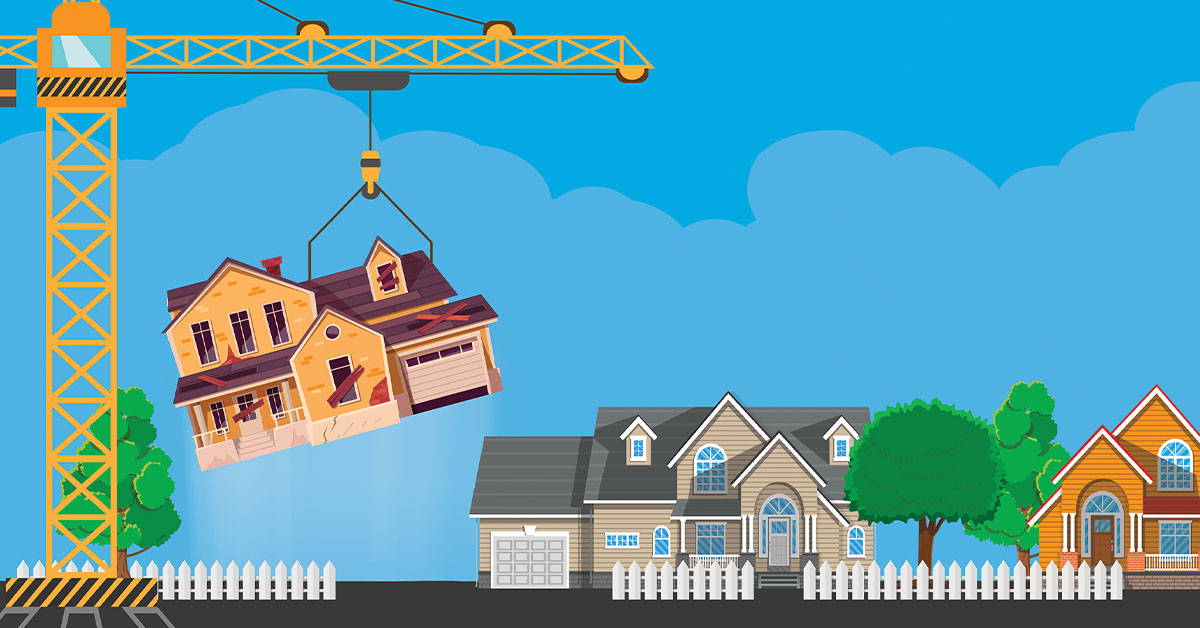Fix-and-flip investors are one of the nation’s busiest groups of single-family homebuyers. In first-quarter 2023, more than 72,000 single-family homes and condominiums were flipped nationwide. These transactions accounted for 9% of all U.S. home sales in the first three months of the year, up from an 8% share in fourth-quarter 2022. Investors are not only growing their rehabilitation or rental businesses — they’re expanding their need for financing and are considering the use of debt on a more frequent basis.
It might be hard to believe that real estate investors, such as fix-and-flippers, are still growing their business. After all, housing inventory remains historically low and mortgage rates continue to tick higher.
“Investors of all types play vital roles in the long-term effort to address the nation’s housing shortage. Ironically, single-family investors can take advantage of low inventory to grow their businesses.”
Nationally, the number of homes for sale fell 15% year over year this past June to reach an all-time low, according to Redfin. The real estate brokerage also reported that new listings fell to 450,000 at that time, down 30.6% from a year earlier for the lowest level and largest annualized decline on record (aside from April 2020, when the COVID-19 pandemic first hit). And according to Zillow, the U.S. needs about 4.3 million more homes to meet current demand.
Adding to the gridlock is the fact that roughly four in five homeowners with a mortgage have an interest rate below 5%, while nearly one-quarter have a rate below 3%, according to Redfin. With interest rates on 30-year fixed-rate loans hovering around 7% late this past summer, nobody was moving unless they absolutely had to.
Inventory problems
Those who are interested in buying a home are watching and waiting to see if the Federal Reserve continues to raise benchmark interest rates in an effort to fight inflation. Prospective buyers may also have to contend with a reduction in lending activity in light of the failures earlier this year of Silicon Valley Bank, Signature Bank and First Republic Bank.
Builders are attempting to make a dent in the ongoing housing shortage, with the National Association of Home Builders reporting a seasonally adjusted annual rate of 983,000 single-family construction starts in July 2023 (up 6.7% year over year). But in spite of significant homebuilding and rehabilitation activity in recent years, there are roughly 16 million vacant homes in the U.S., and it’s a good bet that a large percentage of these need renovation.
“In spite of significant homebuilding and rehabilitation activity in recent years, there are roughly 16 million vacant homes in the U.S., and it’s a good bet that a large percentage of these need renovation.”
On the positive side for housing supply is that independent investors are finding these homes, fixing them up and reselling them to owner occupants in the middle-income range, helping to close the inventory shortage. Independent investors are projected to revitalize 350,000 homes in 2023.
In short, these small, localized investors are taking matters into their own hands and opportunistically filling in the gaps in housing inventory when government bodies and homebuilders fall short. To better accomplish these tasks, these people need financing.
Use of leverage
Historically, many independent real estate investors have used cash to acquire and rehab properties. But despite recent interest rate hikes, investors have grown more comfortable using leverage to fund their deals. Often, this backing comes from private lenders that are usually faster and more flexible to fund a project than conventional lenders like banks and credit unions.
In doing so, investors can reduce the amount of cash they put into any single property, and they can use the loan to complete the purchase and rehabilitation process or pull cash out of a prior investment. Debt also allows them to do more deals and grow their business with higher returns on equity. In fact, the BRRRR method (buy, rehab, rent, refinance and repeat) is predicated on the sensible and efficient use of debt to build rental portfolios and long-term passive income.
Even investors who already use debt seek diversity when it comes to loan products. They need access to nimble and experienced lenders that offer a variety of loan programs tailored specifically to their real estate investment strategies. On a fix-and-flip project, an investor might need a residential transition loan, which is a way for them to pay for construction, repairs and other business expenses.
With a buy-and-hold rental property, an investor might need a rental landlord loan, also known as a debt-service-coverage ratio (DSCR) loan. This is a type of nonqualified mortgage that uses the rental income generated from an investment property to qualify the borrower.
Each of these loan types are typically underwritten based on the borrower’s credit score, liquidity and experience. They are capped at a percentage of cost (purchase price plus repairs) or after-repair value. DSCR loans are also based on how much a property’s rental income covers the required principal and interest payments.
Alternative options
Investors need lenders with varying appetites for risk. Mortgage brokers should help these clients connect with reliable sources of capital and a proven ability to execute. Deals can happen quickly and investors are often looking for better funding options even as they’re closing a transaction.
Different types of real estate also require different lenders and programs. At any point, an investor might need a residential transition loan, which could take the form of a pure bridge loan, a DSCR loan, or a variety of niche products that support multifamily housing, mobile homes, raw land or ground-up construction.
Many investors also operate across multiple markets. While fix-and-flippers usually renovate homes in their own backyards, or specialize in a city or region, they can range far and wide to find the most profitable opportunities and diversify risk.
Buy-and-hold rental investors may build portfolios in multiple cities where they can find value-add opportunities at below-market prices. They may buy in markets as diverse as Boston, Dallas, Houston and Charlotte, and the strategies for acquiring, selling or recapitalizing these properties can vary significantly — hence the need for local lending expertise.
Strategic support
Investors of all types play vital roles in the long-term effort to address the nation’s housing shortage. Ironically, single-family investors can take advantage of low inventory to grow their businesses.
This is because they buy homes that may be uninhabitable, or those which the average consumer homebuyer simply doesn’t have the appetite or experience to renovate. Often, rehabbers also have the knowledge and resources to complete a project on time and on budget, and they make design decisions that are likely to be in high demand among most end buyers.
They can do all this work much more easily by partnering with commercial mortgage originators and capital sources that have experience and a high level of understanding of the investment landscape. They also need access to more than one lender, thus ensuring depth and diversity of mortgage programs and risk appetites.
A real estate investor might be looking to make an actual purchase while pricing a hypothetical deal (or a handful of deals) at the same time. They may be closing on one project and starting another simultaneously, and therefore need bridge financing to move quickly.
These investors can greatly benefit from a marketplace that supports their many strategies by offering multiple funding sources and programs, all with a central point of contact across the real estate investment space. This would enable lenders and brokers to more efficiently widen their originations pipeline, lower the costs of acquisition and quickly scale up their lending portfolios. In other words, such a marketplace would make it easier for mortgage professionals to up their game in an increasingly competitive landscape.
Increased speed and minimized friction are essential for lenders and brokers who seek to grow their businesses and encourage repeat customers. Borrowers will return to a marketplace when they know they can find the best available options and feel confident they are getting the best value.
● ● ●
Independent single-family home investors continue to play a critical role in the real estate market, and their impact is growing. Many iBuyers — companies that use automated valuation models to buy homes quickly — and large institutional investors have either left the playing field or have dramatically scaled back their operations for now. But the local players, knowing they can source and close attractive financing to support future growth, are leaning in and taking action with confidence.
With the housing shortage expected to continue for the foreseeable future, fix-and-flip investors will remain important drivers of inventory replenishment and growth in the market. They’ll generate a variety of attractive and repeat business opportunities for mortgage lenders and brokers for years to come. ●
Author
-

Jason Hutton is senior vice president and chief operating officer of Sherman Bridge, which provides fast and reliable capital for real estate investors. Through its proprietary marketplace, The Bridge, the company offers a variety of vetted and flexible debt options to help borrowers purchase and rehab investment properties to either sell or rent. Financing provided through The Bridge makes it possible for investors to take on more projects at the same time, make extensive improvements and scale their real estate investment business faster.





